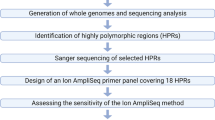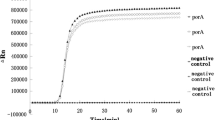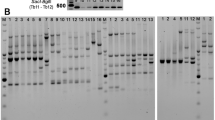Abstract
The aim of this paper is to develop an applicable Random Amplified Polymorphic DNAs (RAPD) method for genotyping Neisseria gonorrhoeae strain, and discuss the possibility of using the RAPD method to trace N. gonorrhoeae strain transmission route. Four different pretreatment methods were used on the N. gonorrhoeae genomic DNA component, and the best adaptive extract method was selected for RAPD. Different RAPD primers sequence was used for amplification and their differentiating capabilities for N. gonorrhoeae strains were compared. Applicable RAPD primer was selected for N. gonorrhoeae genotyping and then applied into transmission detection. The results show that the so called cetyl-trimethylammonium bromide (CTAB) method for extracting genomic DNA could give integrated genomic DNA and give out relatively better RAPD fingerprint maps, subsequently, using selected RAPD primer could give out a group of amplification polymerase chain reaction bands. The fingerprint maps from different N. gonorrhoeae strains were distinctive. Some main segments were common to all the N. gonorrhoeae strains tested. Some segments were different among the N. gonorrhoeae strains. According to the fingerprint maps and similarity index of different N. gonorrhoeae isolates, isolates from a pair of sex-partners were very similar. Based on these findings, the best extracting method and suitable RAPD primer were chosen. The RAPD fingerprint maps could type N. gonorrhoeae effectively and could be used as an additional approach in molecular epidemiology for tracing infection sources.
Similar content being viewed by others
References
Williams J G, Kubelik A R, Livak K J, Rafalski J A, Tingey S V. DNA polymorphisms amplified by arbitrary primers are useful as genetic markers. Nucleic Acids Res, 1990, 18(22): 6531–6535
Welsh J, McClelland M. Fingerprinting genomes using PCR with arbitrary primers. Nucleic Acids Res, 1990, 18(24): 7213–7218
Akopyanz N, Bukanov N O, Westblom T U, Kresovich S, Berg D E. DNA diversity among clinical isolates of Helicobacter pylori detected by PCR-based RAPD finger-printing. Nucleic Acids Res, 1992, 20(19): 5137–5142
Sandstrom E G, Chen K C, Buchanan T M. Serology of Neisseria gonorrhoeae: coagglutination serogroups WI and WII/III correspond to different outer membrane protein I molecules. Infect Immun, 1982, 38(2): 462–470
Thyaer J D, Martin J E Jr. Improved selective medium for cultivation of N. gonorrhoeae and N. meningitidis. Public Health Rep, 1966, 81(6): 559–562
Fred M A, Roger B, Robert E K, David D M, Seidman J G, Smith J A, Kevin S. Short protocols in molecular biology 3rd ed. New York: John Wiley & Sons, Inc. 1995, 2–11
Chalkley L J, Janse van Rensburg M N, Matthee P C, Ison C A, Botha P L. Plasmid analysis of Neisseria gonorrhoeae isolates and dissemination of tetM genes in southern Africa 1993–1995. J Antimicrob Chemother, 1997, 40(6): 817–822
Todd K, Durrheim D, Pickles R, Eastwood K, Merritt T, Tapsall J, Ray S, Limnios A. Using epidemiological and molecular methods to investigate an outbreak of gonorrhoea associated with heterosexual contact in Newcastle, NSW, Australia. Sex Health, 2007, 4(4): 233–236
Bilek N, Martin I M, Bell G, Kinghorn G R, Ison C A, Spratt BG. Concordance between Neisseria gonorrhoeae genotypes recovered from known sexual contacts. J Clin Microbiol, 2007, 45(11): 3564–3567
Moodley P, Martin I M, Ison C A, Sturm A W. Typing of Neisseria gonorrhoeae reveals rapid reinfection in rural South Africa. J Clin Microbiol, 2002, 40(12): 4567–4570
Spaargaren J, Stoof J, Fennema H, Coutinho R, Savelkoul P. Amplified fragment length polymorphism fingerprinting for identification of a core group of Neisseria gonorrhoeae transmitters in the population attending a clinic for treatment of sexually transmitted diseases in Amsterdam, The Netherlands. J Clin Microbiol, 2001, 39(6): 2335–2337
Ellsworth D L, Rittenhouse K D, Honeycutt R L. Artifactual variation in randomly amplified polymorphic DNA banding patterns. Biotechniques, 1993, 14(2): 214–217
Carlton J M, Howard J, Jense J B, Walliker D. A rapid technique for the detection of DNA polymorphisms in Plasmodium. Exp Parasitol, 1995, 80(1): 163–166
Howard J, Carlton J M, Walliker D, Jensen J B. Use of random amplified polymorphic DNA (RAPD) technique in inheritance studies of Plasmodium falciparum. J Parasitol, 1996, 82(6): 941–946
Hilton A C, Mortiboy D, Banks J G, Penn C W. RAPD analysis of environmental, food and clinical isolates of Campylobacter spp. FEMS Immunol Med Microbiol, 1997, 18(2): 119–124
Camarena J J, Nogueira J M, Dasi M A, Moreno F, Garcia R, Ledesma E, Llorca J, Hernandez J. DNA amplification fingerprinting for subtyping Neisseria gonorrhoeae strains. Sex Transm Dis, 1995, 22(2): 128–136
Zhu X, Kong F, Zhang G, Chen S. Identification and classification of Neisseria gonorrhoeae by RAPD fingerprinting. Chin Med J (Engl), 1995, 108(4): 269–272
Dassanayake R S, Samaranayake L P. Amplification-based nucleic acid scanning techniques to assess genetic polymorphism in Candida. Crit Rev Microbiol, 2003, 29(1): 1–24
Eisen D, Russell E G, Tymms M, Roper E J, Grayson M L, Turnidge J. Random amplified polymorphic DNA and plasmid analyses used in investigation of an outbreak of multiresistant Klebsiella pneumoniae. J Clin Microbiol, 1995, 33(3): 713–717
Ben-Hamouda T, Foulon T, Ben-Cheikh-Masmoudi A, Fendri C, Belhadj O, Ben-Mahrez K. Molecular epidemiology of an outbreak of multiresistant Klebsiella pneumoniae in a Tunisian neonatal ward. J Med Microbiol, 2003, 52(Pt 5): 427–433
Scott M P, Haymes K M, Williams S M. Parentage analysis using RAPD-PCR. Nucleic Acids Res, 1992, 20(20): 5493
Author information
Authors and Affiliations
Corresponding author
Rights and permissions
About this article
Cite this article
Zhang, T., Zhou, X., Zhang, T. et al. Using RAPD in Neisseria gonorrhoeae genotyping and transmission detection. Front. Med. China 2, 269–275 (2008). https://doi.org/10.1007/s11684-008-0051-9
Received:
Accepted:
Published:
Issue Date:
DOI: https://doi.org/10.1007/s11684-008-0051-9




